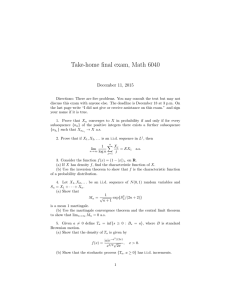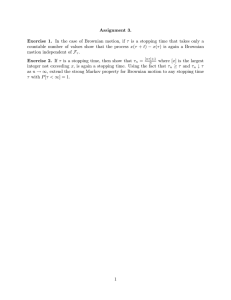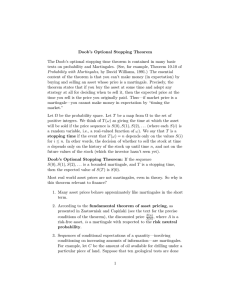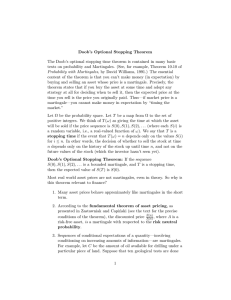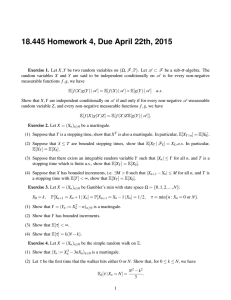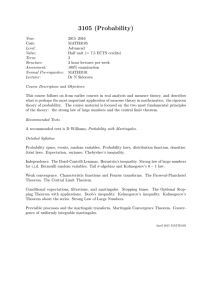Document 13620602
advertisement
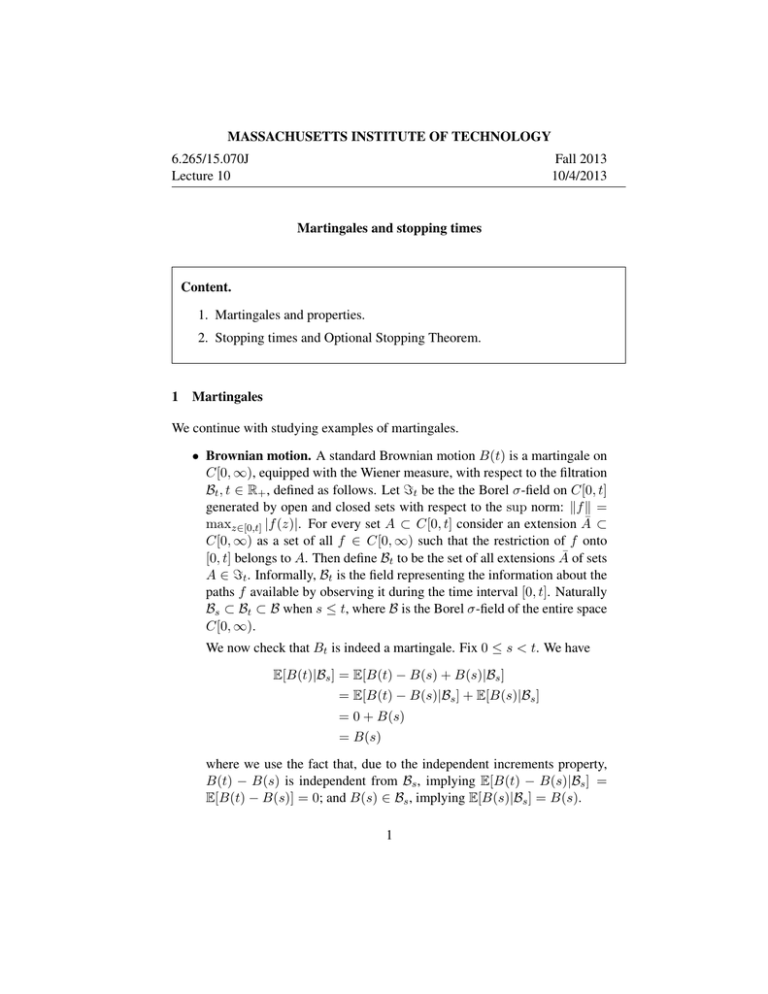
MASSACHUSETTS INSTITUTE OF TECHNOLOGY
6.265/15.070J
Lecture 10
Fall 2013
10/4/2013
Martingales and stopping times
Content.
1. Martingales and properties.
2. Stopping times and Optional Stopping Theorem.
1
Martingales
We continue with studying examples of martingales.
• Brownian motion. A standard Brownian motion B(t) is a martingale on
C[0, ∞), equipped with the Wiener measure, with respect to the filtration
Bt , t ∈ R+ , defined as follows. Let Ct be the the Borel σ-field on C[0, t]
generated by open and closed sets with respect to the sup norm: 1f 1 =
maxz∈[0,t] |f (z)|. For every set A ⊂ C[0, t] consider an extension A¯ ⊂
C[0, ∞) as a set of all f ∈ C[0, ∞) such that the restriction of f onto
[0, t] belongs to A. Then define Bt to be the set of all extensions A¯ of sets
A ∈ Ct . Informally, Bt is the field representing the information about the
paths f available by observing it during the time interval [0, t]. Naturally
Bs ⊂ Bt ⊂ B when s ≤ t, where B is the Borel σ-field of the entire space
C[0, ∞).
We now check that Bt is indeed a martingale. Fix 0 ≤ s < t. We have
E[B(t)|Bs ] = E[B(t) − B(s) + B(s)|Bs ]
= E[B(t) − B(s)|Bs ] + E[B(s)|Bs ]
= 0 + B(s)
= B(s)
where we use the fact that, due to the independent increments property,
B(t) − B(s) is independent from Bs , implying E[B(t) − B(s)|Bs ] =
E[B(t) − B(s)] = 0; and B(s) ∈ Bs , implying E[B(s)|Bs ] = B(s).
1
• Brownian motion with drift. Now consider a Brownian motion with drift
µ and standard deviation σ. That is consider Bµ (t) = µt + σB(t), where
B is the standard Brownian motion. It is straightforward to show that
Bµ (t)−µt is a martingale. Also it is simple to see that (Bµ (t)−µt)2 −σ 2 t
is also a martingale.
• Wald’s martingale. Suppose Xn , n ∈ N is an i.i.d. sequence with
function M (θ) £
E[X1 ] = µ, such that the exponential moment generating
g
θX
1
E[e ] < ∞ for some θ > 0. Let Sn =
1≤k≤n Xk . Then Zn =
exp(θSn )
M n (θ)
2
is a martingale. It is straightforward to check this.
Properties of martingales
Note that if Xn is submartingale, then −Xn is supermartingale and vice verse.
Proposition 1. Suppose Xn is a martingale and φ is a convex function such that
E[|φ(Xn )|] < ∞. Then φ(Xn ) is a submartingale.
Proof. We apply conditional Jensen’s inequality:
E[φ(Xn+1 )|Fn ] ≥ φ(E[Xn+1 |Fn ]) = φ(Xn ).
As a corollary we obtain that if Xn is a martingale and E[|Xn |p ] < ∞
for all n for some p ≥ 1, then |Xn |p is submartingale. Note that if Xn was
submartingale and φ was non-decreasing, then the same result applies.
Definition 1. A sequence of random variables Hn is defined to be predictable if
Hn ∈ Fn−1 .
Here is sort of an artificial example. Let Xn be adapted to filtration Fn .
Then Hn = Xn−1 , H0 = H1 = X0 , is predictable. We simply ”played” with
indices. Instead now consider Hn = E[Xn |Fn−1 ]. By the definition of condi­
tional expectations, Hn ∈ Fn−1 , so it is predictable.
Theorem 1 (Doob’s decomposition). Every submartingale Xn , n ≥ 0 adapted
to filtration Fn , can be written in a unique way as Xn = Mn + An where Mn
is a martingale and An is an a.s. non-decreasing sequence, predictable with
respect to Fn .
2
Proof. Set A0 = 0 and define An recursively by An = An−1 + E[Xn |Fn−1 ] −
Xn−1 ≥ An−1 . Let Mn = Xn − An . By induction, we have that An ∈ Fn−1
since An−1 ∈ Fn−2 ⊂ Fn−1 and E[Xn |Fn−1 ], Xn−1 ∈ Fn−1 . Therefore An
is predictable. We now need to show that Mn is a martingale. To check that
E[|Mn |] < ∞, it suffices to shot the same for An , since by assumption Xn is
a sub-martingale and therefore E[|Xn ] < ∞. Now, we establish finiteness of
E[|An |] by induction, for which it suffices to have finiteness of E[|E[Xn |Fn−1 ]|]
which follows by conditional Jensen’s inequality which gives |E[Xn |Fn−1 ]| ≤
E[|Xn | |Fn−1 ] and the tower property which gives E[E[|Xn | |Fn−1 ]] = E[|Xn |] <
∞. We now establish that E[Mn |Fn−1 ] = Mn−1 . We have
E[Mn |Fn−1 ] = E[Xn − An |Fn−1 ]
= E[Xn |Fn−1 ] − An
= Xn−1 − An−1
= Mn−1 .
Thus Mn is indeed a martingale. This completes the proof of the existence part.
To prove uniqueness, we assume that Xn = Mn� + An� is any such decom­
position. Then
E[Xn |Fn−1 ] = E[Mn� + An� |Fn−1 ] = Mn� −1 + An� = Xn−1 − A�n−1 + A�n
since, by assumption, Mn� is a martingale and A�n is predictable. Then we see
that A�n satisfies the same recursion as An , implying An� = An . It then immedi­
ately follows that Mn� = Mn .
The concept of predictable sequences is useful when we want to model a
gambling scheme, or in general any controlled stochastic process, where we
observe the state Xn−1 of the process at time t = n − 1, take some decision
at time t = n and observe the realization Xn at time t = n. This realization
might actually depend on our decision. In the special case of gambling, suppose
Xn is your wealth at time n if in each round you bet one dollar. In particular,
= ±1. If you instead bet an amount Hn each time, then your net
Xn − Xn−1 g
at time n is 1≤m≤n Hm (Xm − Xm−1 ). Modelling Xn as an i.i.d. coin toss
sequence with the usual product σ-field on {0, 1}∞ , we have Xn is adapted to
the σ-field on {0, 1}n and Hn is predictable.
Is there a scheme which allows us to beat the system? In fact, yes. This
is the famous double the bet strategy. We make H1 = 1 and Hn = 2Hn−1
if Xn−1 − Xn−2 = −1 and stop once Xn−1 − Xn−2 = 1, then assuming we
won the first time in round k, our net worth is −1 − 2 − · · · − 2k−1 + 2k = 1.
3
If P(Xn−1 − Xn−2 = 1) > 0, and the games have independently distributed
outcomes, then we win a.s. a dollar at some random time k.
As we will see this was possible because we did not put a bound on how
long we are allowed to play and how much we are allowed to lose. We now es­
tablish that placing either of this conditions makes beating the gambling system
impossible.
For now we establish the following result.
Theorem
g 2. Suppose Xn is a supermartingale and Hn ≥ 0 is predictable. Then
Zn = 1≤m≤n Hm (Xm − Xm−1 ) is also a supermartingale.
Proof. We have
E[Zn+1 |Fn ] = E[Hn+1 (Xn+1 − Xn )|Fn ] + E[
Hm (Xm − Xm−1 )|Fn ].
1≤m≤n
Since H is predictable, then Hn+1 ∈ Fn , implying that the first summand is
equal to
Hn+1 E[(Xn+1 − Xn )|Fn ] ≤ 0,
where inequality follows since Xn is supermartingale. On the other hand,
Hm (Xm − Xm−1 ) = Zn ∈ Fn ,
1≤m≤n
implying that its expectation is E[Zn |Fn ] = Zn . This completes the proof.
3
Stopping times
In the example above, showing how to create a winning gambling system, notice
that part of the strategy was to stop the first time when we win. Thus the game
is interrupted at a random time, which depends on the observed conditions. We
now formalize this using the concept of stopping times. The end goal of this
section is establishing the following result: if the gambling strategy involves a
stopping time which is bounded, then our expected gain is non-positive.
Definition 2. Given a filtration {Ft }t∈T on a sample space Ω, a random vari­
able τ : Ω → T is called a stopping time, if the event {τ ≤ t} = {ω ∈ Ω :
τ (ω) ≤ t} ∈ Ft , for every t.
Here we consider again the two cases T = N or T = R+ . Note, that we do
not need to specify a probability measure here. The concept of stopping times is
framed only in terms of measurability with respect to σ-fields.
4
• Consider the filtration corresponding to a sequence of random variables
X1 , . . . , Xn , . . .. Namely Ω = R∞ and Fn is Borel σ-field of Rn . Fix
some real value x. Given any sample ω = (ω1 , . . . , ωn , . . .) ∈ R∞ define
X
τ (ω) = inf{n :
ωk ≥ x}.
1≤k≤n
Namely, τ (ω) is the smallest index at which the sum of the components
is at least x. Then τ is a stopping time. Indeed, the event τ ≤ n is com­
pletely specified by the portion ω1 , . . . , ωn of the sample. In particular
X
ωi ≥ x}.
{ω : τ (ω) ≤ n} = ∪1≤k≤n {ω :
1≤i≤k
Each of the events in the union on the right-hand side is measurable with
respect to Fn . This example is the familiar Wald’s stopping time: τ is the
smallest n for which a random walk X1 + · · · + Xn ≥ x, except for, we
do not say that the random sequence should be i.i.d. and, in fact, we do
not say anything about the probability law of the sequence at all.
• Consider the standard Wiener measure on C([0, ∞)), that is consider the
standard Brownian motion. Then, given a > 0, Ta = inf{t : B(t) = a}
is a stopping time with respect to the filtration Bt , t ∈ R+ , where Bt is
the filtration described in the beginning of the lecture. This is the familiar
hitting time of the Brownian motion.
The main result in terms of stopping times that we wish to establish is as
follows.
Theorem 3. Suppose Xn is a supermartingale and τ is a stopping time, which
is a.s. bounded: τ ≤ M a.s. for some M . Then E[Xτ ] ≤ E[X0 ]. In other
words, if there exists a bound on the number of rounds for betting, then the
expected net gain is non-positive, provided that in each round the expected gain
is non-positive.
This theorem will be established as a result of several short lemmas.
Lemma 1. Suppose τ is a stopping time corresponding to the filtration Fn .
Then the sequence of random variables Hn = 1{τ ≥ n} is predictable.
Proof. Hn is a random variable which takes values 0 and 1. Note that the event
{Hn = 0} = {τ < n} = {τ ≤ n − 1}. Since τ is a stopping time, then the
event {τ ≤ n − 1} ∈ Fn−1 . Thus Hn is predictable.
5
Given two real values a, b we use a ∧ b to denote min(a, b).
Corollary 1. Suppose Xn is supermartingale and τ is a stopping time. Then
Yn = Xn∧τ is also a supermartingale.
Proof. Define Hn = 1{τ ≥ n}. Observe that
X
X
Hm (Xm − Xm−1 ) = −H0 X0 +
1≤m≤n
Xm (Hm − Hm+1 ) + Hn Xn .
0≤m≤n−1
(1)
Note, H0 = 1{τ ≥ 0} = 1. Hm − Hm+1 = 1{τ ≥ m} − 1{τ ≥ m + 1} =
1{τ = m}. Therefore, the expression on the right-hand side of (1) is equal to
Xn∧τ − X0 . By Theorem 2, the left-hand side of (1) is a supermartingale. We
conclude that Yn = Xn∧τ is a supermartingale.
Now we are ready to obtain our end result.
Proof of Theorem 3. The process Yn = Xn∧τ is a supermartingale by Corol­
lary 1. Therefore
E[YM ] ≤ E[Y0 ]
But YM = XM ∧τ = Xτ and Y0 = X0∧τ = X0 . We conclude E[Xτ ] ≤ E[X0 ].
This concludes the proof of Theorem 3.
4
Additional reading materials
• Durrett [1] Chapter 4.
References
[1] R. Durrett, Probability: theory and examples, Duxbury Press, second edi­
tion, 1996.
6
MIT OpenCourseWare
http://ocw.mit.edu
15.070J / 6.265J Advanced Stochastic Processes
Fall 2013
For information about citing these materials or our Terms of Use, visit: http://ocw.mit.edu/terms.

